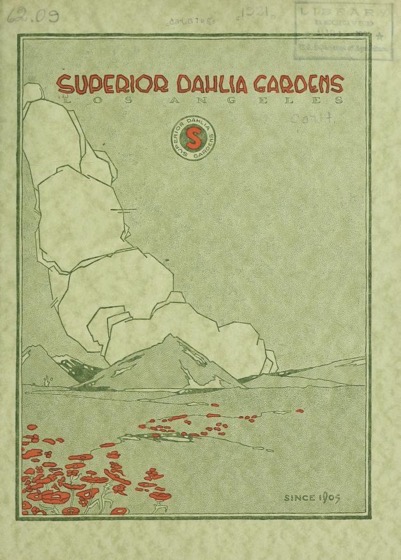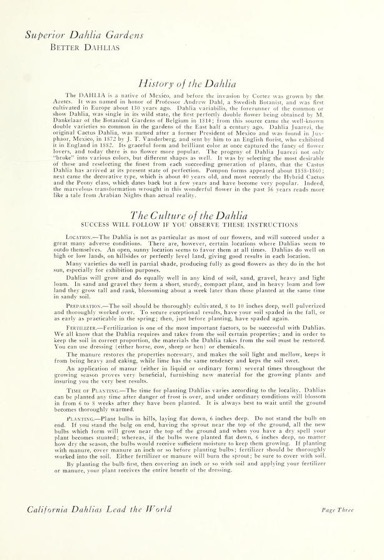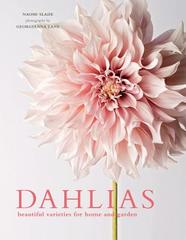Dazzling Dahlias – 59 in a series – Superior Dahlia Gardens Catalog (1921)
History of the Dahlia
The DAHLIA is a native of Mexico, and before the invasion by Cortez was grown by the Azetcs. It was named in honor of Professor Andrew Dahl, a Swedish Botanist, and was first cultivated in Europe about 130 years ago. Dahlia variabilis, the forerunner of the common or show Dahlia, was single in its wild state, the first perfectly double flower being obtained by M. Dankelaar of the Botanical Gardens of Belgium in 1814; from this source came the well-known double varieties so common in the gardens of the East half a century ago. Dahlia Juarezi, the original Cactus Dahlia, was named after a former President of Mexico and was found in Jux- phaor, Mexico, in 1872 by J. T. Vanderberg, and sent by him to an English florist, who exhibited it in England in 1882. Its graceful form and brilliant color at once captured the fancy of flower lovers, and today there is no flower more popular. The progeny of Dahlia Juarezi not only “broke” into various colors, but different shapes as well. It was by selecting the most desirable of these and reselecting the finest from each succeeding generation of plants, that the Castus Dahlia has arrived at its present state of perfection. Pompon forms appeared about 1858-1860 ; next came the decorative type, which is about 40 years old, and most recently the Hybrid Cactus and the Peony class, which dates back but a few years and have become very popular. Indeed, the marvelous transformation wrought in this wonderful flower in the past 36 years reads more like a tale from Arabian Nights than actual reality.
The Culture of the Dahlia
SUCCESS WILL FOLLOW IF YOU OBSERVE THESE INSTRUCTIONS
Location. — The Dahlia is not as particular as most of our flowers, and will succeed under a great many adverse conditions. There are, however, certain locations where Dahlias seem to outdo themselves. An open, sunny location seems to favor them at all times. Dahlias do well on high or low lands, on hillsides or perfectly level land, giving good results in each location. Many varieties do well in partial shade, producing fully as good flowers as they do in the hot sun, especially for exhibition purposes.
Dahlias will grow and do equally well in any kind of soil, sand, gravel, heavy and light loam. In sand and gravel they form a short, sturdy, compact plant, and in heavy loam and low land they grow tall and rank, blossoming about a week later than those planted at the same time in sandy soil.
Preparation. — The soil should be thoroughly cultivated, 8 to 10 inches deep, well pulverized and thoroughly worked over. To secure exceptional results, have your soil spaded in the fall, or as early as practicable in the spring; then, just before planting, have spaded again. Fertilizer. — Fertilization is one of the most important factors, to be successful with Dahlias. We all know that the Dahlia requires and takes from the soil certain properties; and in order to keep the soil in correct proportion, the materials the Dahlia takes from the soil must be restored. You can use dressing (either horse, cow, sheep or hen) or chemicals.
The manure restores the properties necessary, and makes the soil light and mellow, keeps it from being heavy and caking, while lime has the same tendency and keeps the soil sweet.
An application of manur (either in liquid or ordinary form) several times throughout the growing season proves very beneficial, furnishing new material for the growing plants and insuring you the very best results.
Time of Planting. — The time for planting Dahlias varies according to the locality. Dahlias can be planted any time after danger of frost is over, and under ordinary conditions will blossom in from 6 to 8 weeks after they have been planted. It is always best ta wait until the ground becomes thoroughly warmed.
Planting. — Plant bulbs in hills, laying flat down, 6 inches deep. Do not stand the bulb on end. If you! stand the bulg on end, having the sprout near the top of the ground, all the new bulbs which form will grow near the top of the ground and when you have a dry spell your plant becomes stunted; whereas, if the bulbs were planted flat down, 6 inches deep, no matter how dry the season, the bulbs would receive sufficient moisture to keep them growing. If planting with manure, cover manure an inch or so before planting bulbs; fertilizer should be thoroughly worked into the soil. Either fertilizer or manure will burn the sprout; be sure to cover with soil.
By planting the bulb first, then covering an inch or so with soil and applying your fertilizer or manure, your plant receives the entire benefit of the dressing.
An interesting link found among my daily reading


